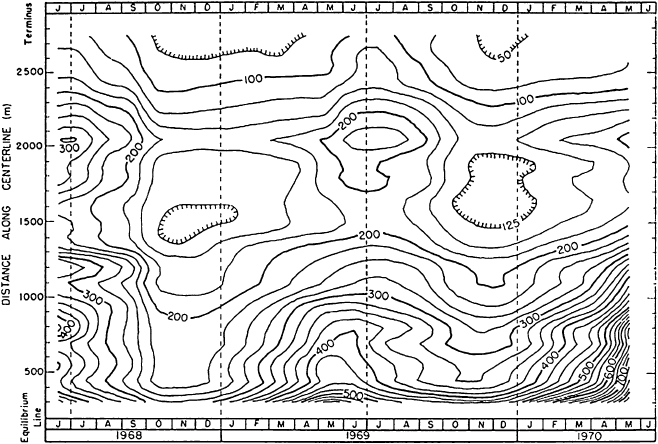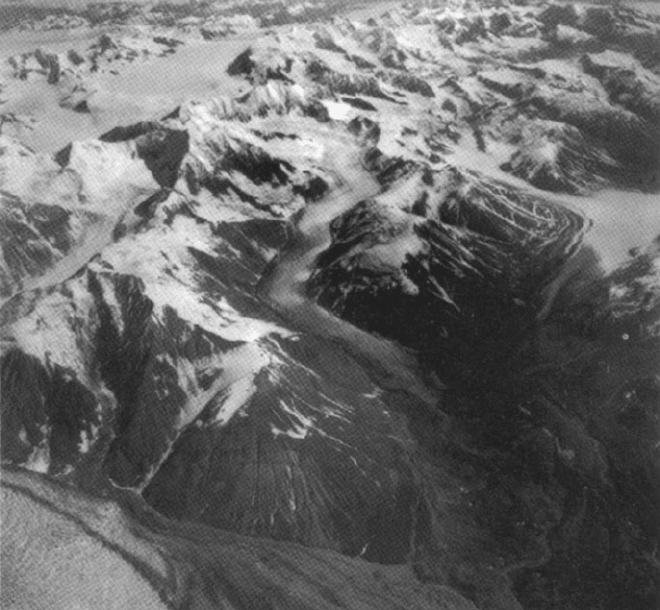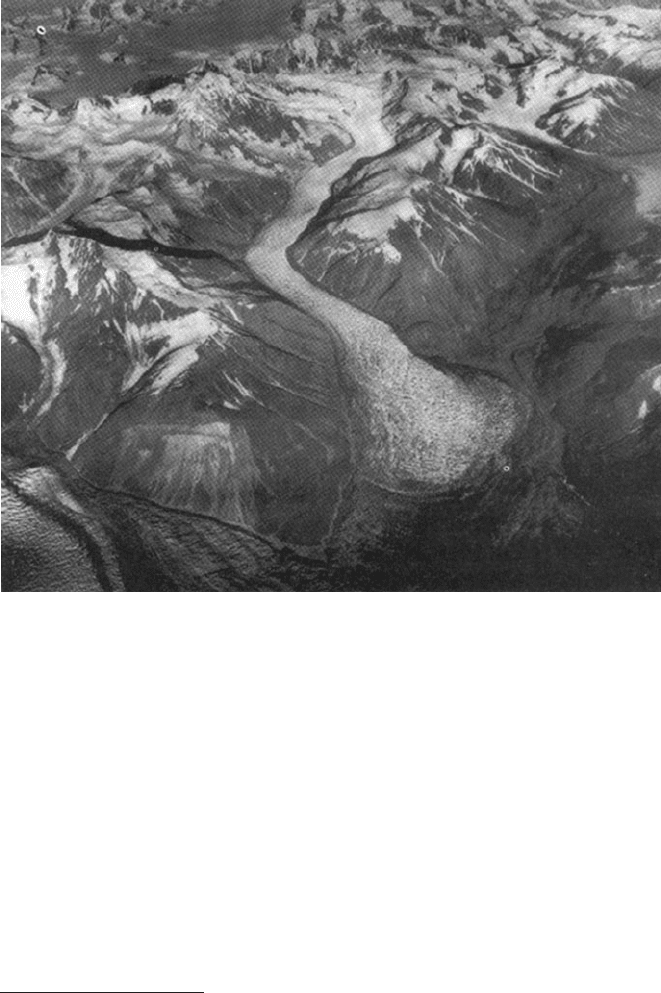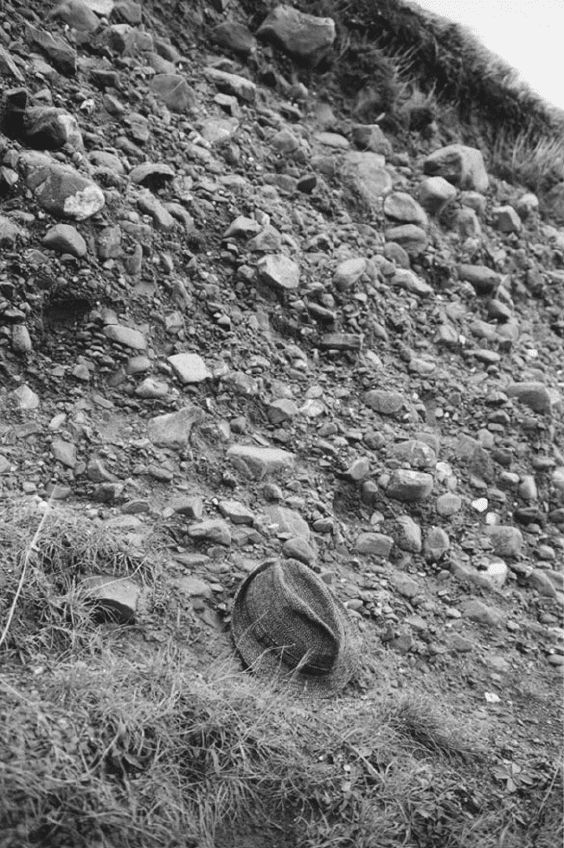Fowler A. Mathematical Geoscience
Подождите немного. Документ загружается.


620 10 Glaciers and Ice Sheets
Fig. 10.2 The measured surface speed of Nisqually Glacier, Mt. Rainier, as a function of time and
distance. The contour interval is 25 mm d
−1
. The maximum and minimum speeds occur progres-
sively later with distance down-glacier; this represents a “seasonal wave” in the ice flow. Repro-
duced from Hodge (1974), and reprinted from the Journal of Glaciology with permission of the
International Glaciological Society
periodic, with periods of the order of 20–100 years. During a long quiescent phase,
the glacier is over-extended and thin. Ice accumulation causes the glacier to thicken
upstream, while the over-extended snout thins and retreats. Eventually, a critical
thickness is reached, and the glacier slumps rapidly downslope again. These surges
will typically last only a year or two, during which time the velocity may increase a
hundred-fold. The glacier snout can then advance by several kilometres.
A typical (and much studied) example is the Variegated Glacier in Alaska. Its
surge periodicity is about twenty years, while its surges last about two years. The
glacier, of length twenty kilometres and depth four hundred metres, advances some
six kilometres during its surge, at measured speeds of up to 65 metres per day.
Such large velocities can only occur by basal sliding, and detailed observations dur-
ing the 1982–3 surge showed that the surge was mediated by an alteration in the
basal drainage system, which had the effect of raising water pressure dramatically.
A dynamic model suggests, in fact, that the oscillations are caused by the compet-
itive interaction between the basal sliding law and the hydraulics of the subglacial
drainage system. When the ice is relatively thin (hence the driving shear stress is
low) the drainage occurs through a network of channels incised into the ice at the
glacier bed called Röthlisberger channels. These allow effective drainage at quite
low water pressures (hence high effective pressures) and thus also low ice veloc-
ities. At higher driving stresses, however, an instability forces the channel system

10.1 Dynamic Phenomena 621
Fig. 10.3 Variegated Glacier at the beginning of a surge, 29 August, 1964. Photograph by Austin
Post, U.S. Geological Survey. From the Glacier Photograph Collection, National Snow and Ice
Data Center/World Data Center for Glaciology, Boulder, Colorado
to close down, and the basal water is forced into cavities which exist between the
ice and bedrock protuberances (such cavities are well known to exist). The water
flow is reduced, and the sudden increase in water pressure causes a sudden increase
in ice velocity—the surge. The transition front between the linked cavity drainage
system and the channel system is nucleated near the maximum depth, and propa-
gates rapidly both upstream and downstream, at (measured) speeds on the order of
hundreds of metres per hour. At the end of the surge, the channel drainage system is
re-established. Figures 10.3 and 10.4 show an aerial view of Variegated Glacier in
pre- and post-surge states.
Our understanding of the Variegated surges relies on the concept of drainage
switch between channelised flow and linked cavities, implicitly for ice flowing over
(hard) bedrock. A rather different situation appears to operate in Trapridge Glacier,
another well-studied surging glacier, in the Yukon. Here the glacier is cold in its
interior (unlike the temperate (at the melting point) Variegated Glacier); and rests
on a thick (∼6 metres) layer of till, sometimes more graphically called boulder

622 10 Glaciers and Ice Sheets
Fig. 10.4 Variegated Glacier at the end of a surge, 22 August, 1965. Photograph by Austin Post,
U.S. Geological Survey. From the Glacier Photograph Collection, National Snow and Ice Data
Center/World Data Center for Glaciology, Boulder, Colorado
clay—a non-uniform mixture of angular rock fragments in a finer-grained, clay-
rich groundmass (see Fig. 10.5). Till has a bimodal grain size distribution, and is
produced by the erosion of brittle underlying bedrock, and is evacuated by the slow
motion of the ice downstream.
The sequence of events which appears to occur as Trapridge thickens is that,
firstly, the basal ice reaches melting point (and the till thaws). When this happens,
the till becomes deformable, and the basal ice can slide over the bed by riding on
the deforming till. The rate at which this occurs depends on the till rheology, where
opinion is currently divided as to whether a viscous or plastic rheology is the more
appropriate.
3
What does seem to be clear is that the water pressure will have a ma-
jor effect. Increasing saturation causes increasing water pressure, which pushes the
3
Note the use of the word ‘appropriate’. As a saturated, granular material, somewhat like soil,
there is little argument that a plastic rheology accommodating a yield stress is the most apposite
description; such a description does not in itself provide an answer to such questions as to whether
till deforms with depth (i.e., shears), or whether discrete slip occurs at the ice-till interface.

10.1 Dynamic Phenomena 623
Fig. 10.5 Subglacial till in a coastally exposed drumlin at Scordaun, Killough, Co. Down, North-
ern Ireland
sediment grains apart and allows them to move more freely, so that in effect en-
hanced water production causes enhanced sliding. In turn, increased sliding causes
increased frictional heating, so that there is a positive feedback which potentially
can cause runaway and consequent surging behaviour. Whether the effect is strong
enough is not obvious, but we shall examine a simple model which suggests that it
may be.

624 10 Glaciers and Ice Sheets
10.1.3 Ice Streams
Although ice sheets also flow under the horizontal pressure gradients induced by
the glaciostatic pressures beneath their sloping surfaces, they rest on essentially un-
sloping bases, and therefore have no advective component in their dynamics. Thus
ice sheets do not, at least on the large scale, exhibit wave motion: the governing
equations are essentially diffusive in character. On a more local scale, however, ice
sheets have interesting phenomena of their own.
Principal among these may be ice streams. Ice sheets do not tend to drain uni-
formly to the margin from their central accumulation zones, but rather the out-
flows from catchment areas are concentrated into fast-moving ice streams. Examples
are the Lambert Glacier in Antarctica and Jakobshavn Isbrae in Greenland, a fast-
moving (more than 10 kilometres per year) outlet glacier.
4
These ice streams gain
their speed by carving out deep channels through which they flow. Indeed, there
is an obvious positive feedback here. The deeper an ice flow, the larger the driv-
ing basal stress, and the warmer the basal ice (due to increased frictional heat and
decreased conductive heat loss), and hence the softer the ice. Both of these effects
contribute to enhanced ice flow, which can explain the formation of such channels,
since the erosive power of ice flow increases with the basal velocity and the basal
shear stress. Indeed, flow of ice over a plane bed is subject to a lateral instability
(much as overland flow of surface water is unstable to the formation of rills and
gullies).
A similar kind of mechanism may operate when ice flows over deforming sed-
iments, as in the Siple Coast of West Antarctica. Here, it is found that the flow
is concentrated into five ice streams, A, B, C, D, and E, which are characterised
by their heavily crevassed appearance. Ice stream B is now known as the Whillans
ice stream, in memory of the glaciologist Ian Whillans. Following this, the other
ice streams have also been named after individuals; specifically, A is Mercer, C is
Kamb, D is Bindschadler and E is MacAyeal. The flow in these ice streams is very
rapid and is due to basal sliding over the underlying sediment (except for the Kamb
ice stream C, which appears to have ‘switched off’ several hundred years ago). Mea-
surements on the Whillans ice stream indicate that the basal water pressure is high
(within 0.4 bar of the overburden pressure), and that it is underlain by some eight
metres of saturated till. A similar instability to that concerning ice flow over hard
bedrock may explain the streaming nature of the flow. Where ice flow is larger, there
is increased water production. If the drainage system is such that increased water
production leads to increased water pressure (as one might expect, e.g. for a Darcy
flow), then the higher water pressure decreases the viscosity of the till, and hence
enhances the ice flow further. This is an instability mechanism, and the limiting fac-
tor is that when ice flow increases, there is increased heat loss from the base, which
acts to limit the increase of melt rate.
4
Jakobshavn has undergone a remarkable acceleration in recent years, doubling its speed from 6 to
12 kilometres a year in the ten years between 1992 and 2003.
10.1 Dynamic Phenomena 625
10.1.4 Ice Shelf Instability
Where continental ice sheets are not diminished by ablation, the ice will flow to the
continental margin, where it will spill into the ocean. This, for example, is the case
in Antarctica, where it is so cold that ordinary mass wastage of the ice is virtually ab-
sent. As a result, ice shelves are formed, which are tongues of floating ice connected
to the grounded ice at the grounding line. The grounding line is a dynamical free
boundary, whose location determines the hold up of land ice, and its determination
is therefore of some interest as regards sea level changes.
Over the past several decades, various arguments have been put forward to sug-
gest that ice shelves are inherently unstable and liable to collapse. This idea was
originally put forward in consideration of the West Antarctic Ice Sheet (WAIS),
much of the grounded part of which lies on a submarine bed. If the WAIS were
to collapse completely, global sea level would rise by some six metres, inundating
many coastal cities.
The basic physical mechanism for this putative catastrophic collapse is a posi-
tive feedback between grounding line retreat and ice flow rate. Since ice shelves are
not resisted at their base, they can plausibly flow more rapidly, and the consequent
drawdown effect will lower ice elevation, thus allowing further grounding line re-
treat. The debate has been fuelled by the remarkable collapse of the Larsen B Ice
Shelf on the Antarctic Peninsula in 2002, which is thought to be due to a climatic
warming trend over recent decades. However, as we shall see below, it is by no
means trivial to pose a theoretically coherent model for grounding line motion, and
the issue of stability remains not fully resolved.
10.1.5 Tidewater Glaciers
If the position of the grounding line indicates a balance between inland ice flow and
ice shelf evacuation, the actual mechanism of break up involves mass wastage by
calving icebergs. Indeed, in the absence of ablation, calving is the way in which
marine ice sheets (i.e., those terminating in the sea) satisfy mass balance.
Glaciers which terminate in the sea are called tidewater glaciers, and are sus-
ceptible to a similar kind of catastrophic retreat to that which may be important for
ice shelves. They also lose mass by calving, but are distinguished from ice shelves
by the fact that the ice is grounded right to the margin. Instability is promoted by
the fact that the calving rate increases with depth of water. If a tidewater glacier
advances (in a cold climate), it will push a ridge of moraine ahead of it, snowplough
style. In a stationary state, the water depth at the calving front will then be less than
it is away from the margin, because of this moraine. Then, if the glacier snout re-
treats due, for example, to a warming trend, the snout will suddenly find itself in
deeper water. The resultant increased calving rate can then lead to a catastrophic
retreat. Just such a rapid retreat was observed in the Columbia Glacier in Alaska,
626 10 Glaciers and Ice Sheets
which retreated some 12 km in twenty years from 1982, and it seems such rapid re-
treat is a common behavioural feature of tidewater glaciers in conditions of warmer
climates.
10.1.6 Jökulhlaups
It will be clear by now that basal water is tremendously important in determining
the nature of ice flow. Equally, the basal water system can fluctuate independently of
the overlying ice dynamics, most notably in the outburst floods called jökulhlaups.
In Iceland, in particular, these are associated with volcanoes under ice caps, where
high rates of geothermal heat flux in the confines of a caldera cause a growing sub-
glacial lake to occur, Eventually this overflows, causing a subglacial flood which
propagates down-glacier, and whose subsequent emergence at the glacier termi-
nus releases enormous quantities of water over the southern coastal outwash plains.
These floods carry enormous amounts of volcanic ash and sediments, which create
vast beaches of black ash. Despite their violence, the ice flow is hardly disturbed.
Jökulhlaups are essentially internal oscillations of the basal drainage system. They
are initiated when the rising subglacial lake level causes leakage over a topographic
rim, and the resultant water flow leads to an amplifying water flow by the follow-
ing mechanism. Water flow through a channel in ice enlarges it by meltback of the
walls due to frictional heating. The increased channel size allows increased flow,
and thus further enlargement. The process is limited by the fact that the ice tends to
close up the channel due to the excess overburden pressure over the channel water
pressure, and this is accentuated when the channel is larger. In effect, the opening
of the valve by the excess lake pressure is closed by the excess ice pressure. These
floods occur more or less periodically, every five to ten years in the case of one of
the best known, that of Grímsvötn under Vatnajökull in South-east Iceland. A theory
for their formation is the subject of Chap. 11.
10.2 The Shallow Ice Approximation
10.2.1 Glaciers
We consider first the motion of a glacier in a (linear) valley. We take the x axis in the
direction of the valley axis, z upwards and transverse to the mean valley slope, and y
across stream. The basic equations are those of mass and momentum conservation,
which for an incompressible ice flow (neglecting inertial terms) are
∇.u =0,
0 =−∇p +∇.τ +ρg,
(10.1)

10.2 The Shallow Ice Approximation 627
Fig. 10.6 Typical profile of a
valley glacier
where g is the gravity vector, p is the pressure, and τ is the deviatoric part of the
stress tensor. These are supplemented by the energy equation, which can be written
in the form
ρc
p
(T
t
+u.∇T)=k∇
2
T +τ
ij
˙ε
ij
, (10.2)
where ρ is ice density, c
p
is specific heat, and k is thermal conductivity. The sum-
mation convention is employed in writing the viscous dissipation term.
5
We focus
for the present on the mass and momentum equations, and will deal with the energy
equation later.
The stress and strain rate are related by
τ
ij
=2η ˙ε
ij
, (10.3)
where η is the effective viscosity, and ˙ε
ij
is the strain rate
˙ε
ij
=
1
2
∂u
i
∂x
j
+
∂u
j
∂x
i
. (10.4)
The most common choice of flow law is known as Glen’s law, that is,
˙ε
ij
=A(T )τ
n−1
τ
ij
, (10.5)
where the second stress invariant is given by 2τ
2
= τ
ij
τ
ij
(using the summation
convention) and A(T ) is a temperature-dependent rate factor which causes A to
vary by about three orders of magnitude over a temperature range of 50 K: variation
of A is thus significant for ice sheets (which may be subject to such a temperature
range), but less so for glaciers. If we adopt the configuration shown in figure 10.6,
then g =(g sin α, 0, −g cos α), where α is the mean valley slope downhill.
Boundary conditions for the flow are conditions of equal normal stress at the top
surface z = s(x,y,t); that is σ
n
=−p
a
n, where p
a
is atmospheric pressure, or in
coordinate form, σ
ij
n
j
=−p
a
n
i
, where n ∝(−s
x
, −s
y
, 1):
(−p +τ
11
)s
x
+τ
12
s
y
−τ
13
=−p
a
s
x
,
τ
12
s
x
+(−p +τ
22
)s
y
−τ
23
=−p
a
s
y
,
τ
13
s
x
+τ
23
s
y
−(−p +τ
33
) =p
a
.
(10.6)
5
The summation convention is essentially a device for omitting summation signs; it asserts that
summation is implied over repeated suffixes; thus τ
ij
˙ε
ij
means
i,j
τ
ij
˙ε
ij
.

628 10 Glaciers and Ice Sheets
At the base z =b(x,y,t), we prescribe the velocity:
u =u
b
,v=v
b
,w=ub
x
+vb
y
; (10.7)
(u
b
,v
b
) is the (horizontal) sliding velocity, whose form is discussed later (as are
appropriate temperature conditions). Finally, the kinematic condition on the free
surface z =s is
w =s
t
+us
x
+vs
y
−a, (10.8)
where a is the prescribed surface accumulation: positive for ice accumulation from
snowfall, negative for ice ablation by melting.
A major simplification ensues by adopting what has been called the shallow ice
approximation.
6
It is the lubrication theory idea that the depth d the glacier length
l, and is adopted as follows. We scale the variables by putting
u ∼U; v, w ∼εU;
x ∼l; y,z,b,s ∼d; t ∼l/U;
τ
13
,τ
12
∼[τ ]; A ∼[A]; a ∼[a];
p −p
a
−(ρg cos α)(s −z) ∼ε[τ ];
τ
11
,τ
22
,τ
33
,τ
23
∼ε[τ],
(10.9)
where
ε =
d
l
(10.10)
is the aspect ratio, and we anticipate ε 1. The choice of d and [τ ] has to be
determined self-consistently; we choose l from the given spatial variation of accu-
mulation rate, and we choose U via εU =[a], which balances vertical velocity with
accumulation rate. If we choose [τ ]=ρgd sin α, and define
μ =ε cot α, (10.11)
then the scaled momentum equations are
∂τ
12
∂y
+
∂τ
13
∂z
=−1 +μ
∂s
∂x
+ε
2
∂p
∂x
−
∂τ
11
∂x
,
∂s
∂y
=
ε
2
μ
−
∂p
∂y
+
∂τ
12
∂x
+
∂τ
22
∂y
+
∂τ
23
∂z
,
∂p
∂z
=
∂τ
13
∂x
+
∂τ
23
∂y
+
∂τ
33
∂z
.
(10.12)
The boundary conditions (10.7) and (10.8) are unchanged in form, and the stress
conditions at the top surface z =s(x,y,t) (10.6) become
ε
2
(−p +τ
11
)s
x
+τ
12
s
y
−τ
13
=0,
τ
12
s
x
+(−p +τ
22
)s
y
−τ
23
=0,
τ
13
s
x
+τ
23
s
y
−(−p +τ
33
) =0.
(10.13)
6
The term arose during a discussion about glacier dynamics one tea time in the Mathematical
Institute, Oxford, in 1976. It was invented in keeping with the fluid mechanical description of long
waves known as shallow water theory.

10.2 The Shallow Ice Approximation 629
Table 10.1 Typical values of constants for ice flow in glaciers and, where different, ice sheets. The
activation energy for ice flow is the value appropriate between −10° and 0°C. For temperatures less
than −10°, E =60 kJ mol
−1
. For shear-dominated flows such as ice sheets, it is the warmer value
which is more relevant
Symbol Definition Glacier value Ice sheet value
[a] accumulation rate 1 m y
−1
0.1my
−1
[A] flow rate constant 0.2 bar
−n
y
−1
c
p
specific heat 2 kJ kg
−1
K
−1
E activation energy 139 kJ mole
−1
g gravity 9.8 m s
−2
G geothermal heat flux 60 mW m
−2
k thermal conductivity 2.2 W m
−1
K
−1
l length 10 km 3,000 km
L latent heat 3.3 ×10
5
Jkg
−1
n Glen exponent 3
R gas constant 8.3 J mole
−1
K
−1
sinα slope 0.1 n/a
T
M
melting temperature 273 K
T surface temperature deficit 20 K 50 K
ρ ice density 917 kg m
−3
To get some idea of typical magnitudes, use values d ∼ 100 m, l ∼ 10 km,
tanα ∼0.1; then ε ∼10
−2
, μ ∼10
−1
, so that to leading order s =s(x,t) and
∂τ
12
∂y
+
∂τ
13
∂z
=−1 +μ
∂s
∂x
; (10.14)
we retain the μ term for the moment.
The final relation to choose d (and hence also [τ]) is determined by effecting a
balance in the flow law. If the viscosity scale is [η], then we choose
[τ ]=
[η]U
d
. (10.15)
For example, for Glen’s law, we can choose [η]=
1
2[A][τ ]
n−1
, from which we find
d =
[a]l
2[A](ρg sin α)
n
1/(n+2)
, (10.16)
which leads, using typical choices of the parameters given in Table 10.1, to values
of d comparable to those observed (d =128 m).
The two important shear stresses are given by
τ
13
=η
∂u
∂z
+ε
2
∂w
∂x
,τ
12
=η
∂u
∂y
+ε
2
∂v
∂x
, (10.17)
